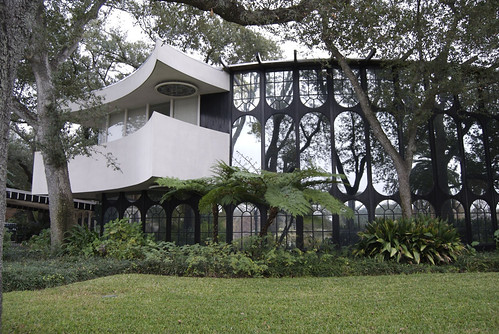In 1994 Tulane School of Architecture sponsored a tour, "The International Style in New Orleans" which featured six modern buildings designed by alumni and faculty in New Orleans: Nathaniel C. Curtis, Jr., Arthur Q. Davis, John Lawrence, James Lamantia, Albert C. Ledner, and August Perez, Jr. This is the fourth of six posts in a series.

Galatoire / Tampira House
11 Park Island Drive
Architect: Albert C. Ledner
This home blends antique and contemporary, delicate windows and massive curving surfaces. Mrs. Galatoire spent much of her life collecting components from buildings slated for demolition, and the architect took up the challenge of incorporating them into a coherent home.
The entry drive and courtyard are paved with cobblestones from the site of the International Trade Mart, and the courtyard features an antique three-tier iron fountain in a reflecting pool. Arched fan doors from the Garden District home of Josephine Louise Newcomb serves as the entrance.
Mrs. Galatoire’s collection of windows from the Good Shepherd Convent (built in 1866 at Bienville and Broad Streets for the care of delinquent girls) includes the arched windows that form the front of the house and eleven stained glass ceiling fixtures. To the right of the entryway is a guest suite. The bath features a Portuguese carved door dating to the mid-eighteenth century, collected from the home of Archbishop John Shaw. Bronze faced window benches with antique tiles from the Shaw house are seen in the bedroom, living room and television room.
Stone is important in this home. The downstairs floor is white marble, and several bathrooms include marble as well. The circular wall behind the dining room and living area is of granite. The curving lines of the building are particular striking as the balcony passes through the arched windows upstairs. Equally compelling is the view of Bayou St. John. The back stairway is also an exercise in curves. It spirals tightly, and the newel post is a series of stacked balls.
Mrs. Galatoire’s eclectic tastes are evident in the kitchen: the cooking island, crafted from a single brass column, was once the service counter of a downtown bank. An antique door of glass and metal is from Spain.
More recent owners have added a memento from another chapter in New Orleans history: the Floating Leaves from the 1984 World’s Fair Wonder Wall, designed by Kent Bloomer of the Yale Art Department.
________________________________________________
The International Style in New Orleans, Tulane School of Architecture, 1994, copy by Patty Andrews
photo: Francine Stock

No comments:
Post a Comment